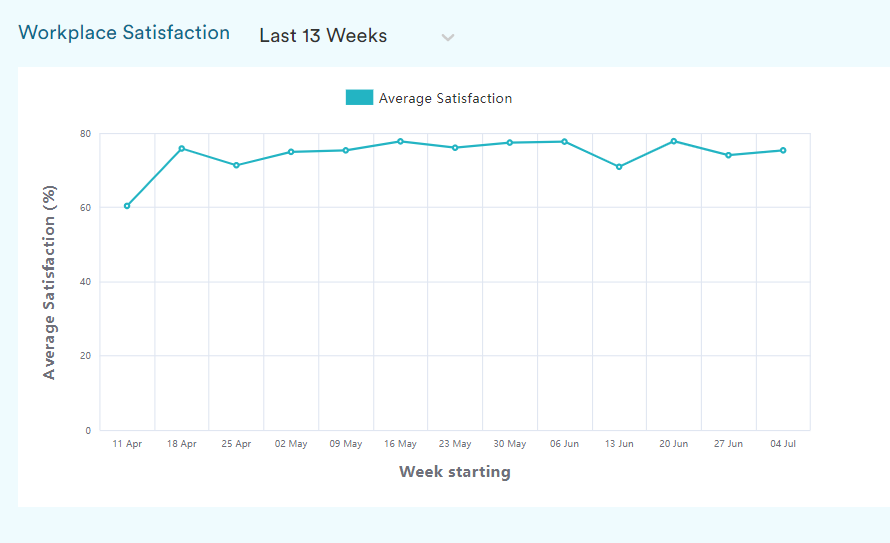
Podium Property Insights: Sentiment and Behaviour
As some employees adapt to the hybrid work model and tentatively return to the office, their experience of the workplace has a significant impact on their satisfaction – making it vital to understand place sentiment and behaviour in order to shape the thriving workplace of the future.
Most workplaces were designed pre-pandemic, with a primary focus on optimising space utilisation and productivity. The impact of COVID-19 has led to a growing understanding of the importance of employee satisfaction when managers rethink workplace design. They are entering uncharted waters, meaning they need to base their decisions on reliable and up-to-date data, rather than outdated assumptions, anecdotal evidence and gut instinct.
The relationship between employees and their work space has forever changed. After the struggles of the pandemic, today 38 per cent of employees say they do not know the purpose of the workplace. Despite this lack of clarity, they are being transitioned to the hybrid office, with 50 per cent of business leaders planning to mandate full-time work from the office within 12 months.
To find success, business leaders need to understand what employees want and need from the workplace in order to make it relevant and productive. This must start with an appreciation that not all employees view and engage with the workplace in the same way.
Looking at the initial findings from Podium Property Insights pilot buildings, the reasons why employees attend the office can be broken into four key categories. Almost half (46 per cent) of employees consider themselves as "occasional visitors" who attend the workplace one day a week, but only one or two weeks per month. Another quarter (23 per cent) are "event attenders" who view the office as the new offsite and only attend for several hours at a time, but again not every week.
Meanwhile, 9 per cent are "regular returners", who go back to work frequently within a week, but not necessarily across weeks. That leaves only 22 per cent as "persistent returners" who have truly embraced hybrid working, regularly coming into the office a few days, most if not every week.
Understanding these different groups within the workforce is vital. Amid changing employee expectations and the increasing struggle to attract and retain the best talent, workplace managers can't afford to ignore place sentiment and behaviour when reshaping the workplace. They must humanise their view of the office to have a greater understanding of how workplace space decisions impact people.
Even if pre-pandemic workspace decisions were influenced by an analysis of employee sentiment and concerns, most organisations still lack the ability to measure and track the effectiveness of these decisions. They also lack the ability to know whether previous decisions continue to best meet the changing needs of employees and the business.
When it comes to wide-ranging insight into the relationship between employees and the workplace, employee satisfaction is the hero metric. Not only is it a key driver of employee retention, it is also a key driver of critical business outcomes such as higher productivity and revenues.
To meet the challenge of better understanding employee satisfaction, 16 per cent of employers are using technology to monitor employee behaviour, according to Gartner. This includes methods such as virtual clocking in and out, tracking work computer usage and monitoring employee emails or internal communications and chat.
While some companies only use such technology to track productivity, others go further by monitoring employee engagement and well-being, in order to better understand employee experience.
These insights can guide workplace managers in transforming physical workspaces to ensure space design and utilisation remain attuned to the changing needs of different people and teams. This extends from straightforward initiatives like improving meeting room availability to more complex initiatives such as increasing workplace attendance and employee engagement.
Employee surveys are certainly a useful tool for assessing satisfaction, including place sentiment, but actions can speak louder than words. Employee behaviour and communication often carry underlying information as to how they feel about their workplace. Sentiment analysis converts this unstructured data into actionable insights. This offers a more holistic view of how employees feel about their workplace and the impact this sentiment has on them, their team and the wider business.
This kind of initiative is welcome, with 87 per cent of employees wanting their leaders to reconsider how technology is being used in the workplace and do better, according to Accenture.
Using these insights to improve human-centric work design – featuring flexible work experiences, intentional collaboration opportunities and empathic management – can increase employee performance by as much as 54 per cent, according to Gartner.
The challenge is that most established Integrated Workplace Management Systems and Building Management Systems only provide broad data visualisation tools and perhaps some basic rules-base intelligence. They generally lack true AI-led insight generation, which can draw together a wide range of data to support improved decision making.
Podium Property Insights correlates building data with employee data to provide the clearest understanding of what drives employee sentiment. It can dynamically capture behaviour, along with place sentiment, to not only visualise data but also provide unprecedented actionable insights around place sentiment and behaviour.
As well as drawing on a range of real-time building metrics, the platform can tailor surveys and questions through workplace tools such as Microsoft Teams, as well as perform human behavioural modelling.
Along with understanding employee sentiment and behaviour, Podium Property Insights can correlate these insights with specific teams as well as specific locations, such as buildings and floors.
Unifying this employee and geospatial data to unlock place sentiment and behaviour insights can inform initiatives designed to reshape the workplace to drive both productivity and employee satisfaction. It is an opportunity for the employee experience to help shape the thriving workplace of the future, to ensure the business is in the strongest position to meet the challenges which lie ahead.
